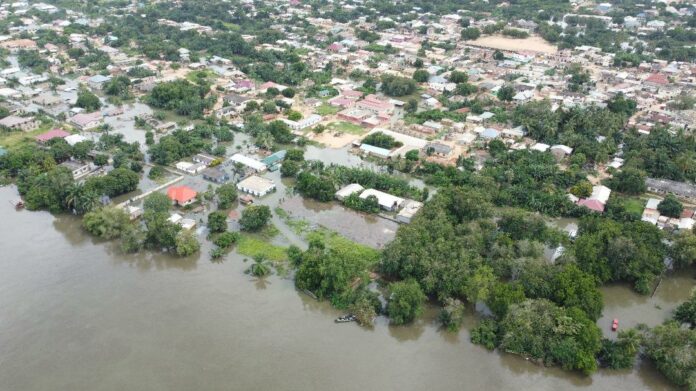In recent weeks, Ghana has been hit by a devastating flood crisis, causing distress for thousands of its citizens. The heart of this predicament lies in the controlled spillage of excess water from the Akosombo and Kpong hydroelectric dams, nestled near Lake Volta’s southern end. This article delves into the dual role of the Akosombo Dam in Ghana as a vital energy source and a force behind flooding disasters.
The construction of large dams gained momentum from the 1930s to the 1970s, with thousands of such projects worldwide by 1949. Dams were seen as symbols of modernization and economic growth, particularly through hydroelectric power generation. Electricity access is a crucial element for economic development, touching everything from industry to security and public services.
Ghana, the first Sub-Saharan African country to gain independence, saw its early access to electricity limited to colonial-era diesel generators. The idea of harnessing hydroelectric power from the Volta River, leading to the construction of the Akosombo Dam, emerged as a way to foster industrialisation.
Constructed in the 1960s, the Akosombo Dam stands as a testament to Ghana’s pursuit of industrialisation and energy security. This ambitious project was the brainchild of Ghana’s first President, Kwame Nkrumah, and aimed to catalyze the country’s development.
The dam project attracted the interests of both the UK and US governments, albeit for different reasons. While the UK saw it as a way to secure cheap aluminium for its industries, the US aimed to counter Soviet influence in Africa.
The World Bank also got involved, providing substantial financial support for the project. Akosombo and its sibling, the Kpong Dam, contribute a significant portion of Ghana’s energy supply, generating about one-third of the nation’s electricity.
The dams provide electricity to not only the citizens of Ghana but also neighbouring countries such as Togo, Benin, and Burkina Faso.
Ghana’s recent flooding predicament can be attributed to a confluence of factors. Unpredictable rainfall patterns, likely exacerbated by climate change, have swelled the water levels in both dams.
As a result, officials from the Volta River Authority (VRA), responsible for managing these dams, initiated controlled spillage to prevent the dams from reaching their maximum safe operational levels, which could lead to catastrophic breaches. Despite the necessity of such measures, the consequences of the floods are far-reaching.
The flood crisis has affected at least Nine Districts in the Volta, Eastern and Greater Regions leaving countless homes submerged and entire communities grappling with the aftermath.
The worst hard-hit districts have however been the Central, South, and North Tongu Districts in the Volta Region of Ghana. It’s estimated that around 40,000 individuals have been displaced by the flood, caught unaware and struggling to save their possessions.
The impacts extend to crucial infrastructure including toilets, cemeteries, and refuse dumps. The fear of disease outbreaks looms large, and essential services such as water and electricity are disrupted with schools closed thereby affecting access to education for thousands of school-going children.
This is not the first time the dam has flooded and destroyed lives and properties. There was a similar situation in the 1960s and just as it is happening currently, the flood in the 1960s not only flood and dislocated homes and livelihood of the mainly rural and tribal people but also affected the environment, submerging the rich forest, tributaries, animals and cultural heritage of the people.
This physical and livelihood displacement affected over 739 villages and 80,000 people in the process.
These communities who lived together for decades were socially, economically, and geographically excluded from existing social networks, lived desperately in fear with damaged dignity, and underwent mental psychological stress leading to untold hardships.
Women and children were the most affected. The subsequent resettlement efforts have left much to be desired, with limited focus on the economic and social development of the displaced populations.
Generally, the problems associated with the dam were caused by the lack of adequate social and environmental impact assessments with the ecological concerns being an afterthought and only taken up when they started to manifest in the affected communities.
The resettlement planning and execution reflects a top-down socio-technical engineering effort, which accorded very little consideration to the agential capabilities of the people displaced and their host populations.
To deal with the current situation caused by the spillage of the Akosombo dam, the government, civil society, development organizations, and individuals must intensify the provision of relief items to affected communities by offering shelter, food, clean water, and medical assistance to the victims.
The Volta River Authority (VRA) must up its communications and warning systems to alert communities about imminent flood threats and advise them on necessary precautions. The government must implement well-organised evacuation plans for at-risk areas, ensuring that people can move to safer locations swiftly.
The government must also as a matter of urgency utilize the Ghana Armed Forces and the Ghana Police Service to deploy temporary flood barriers and sandbags to help protect critical infrastructure, vulnerable areas, and lives.
The Ministry of Health and the Ghana Health Service must implement disease control measures, such as vaccination campaigns and water purification efforts, to mitigate health risks in the flooded communities and regions.
In the medium term, the government must invest in infrastructure improvements, such as building better drainage systems, and flood protection structures, and reinforcing critical facilities to withstand floods.
The VRA and government must conduct public awareness campaigns on flood preparedness, including educating residents about safety measures, evacuation routes, and early warning signals.
The Environmental Protection Agency and Land Use and Spatial Planning Authority (the Town and Country Planning Department) at the various Metropolitan, Municipal and District Assemblies (MMDAs) must implement strict land-use planning and zoning regulations to discourage construction in flood-prone areas and to manage urban expansion.
The National Insurance Authority and Insurance companies must encourage the availability of affordable flood insurance for residents to protect their homes and belongings.
In the long term, it is recommended that government takes conscious measures to address the impacts of large dams on the livelihood of local resettled people, downstream communities, and the ecosystem, and ensure that the costs associated with these impacts are internalised in the project accounting and planning processes.
The ongoing challenge underscores the need for more comprehensive social and environmental impact assessments and a bottom-up socio-technical engineering approach.
Government must formulate and implement robust Water Resource Management and Governance Strategies with a designated institution which can develop, coordinate and implement frameworks to ensure broader water and energy sustainability.
To ensure the effectiveness of post‐dam construction programmes, people affected by dams, members of civil society, and the authority operating the dams should set up an independent monitoring group outside the ambit of the central government to report on and evaluate the implementation process and effectiveness of the programmes.
The government should consider undertaking large-scale ecosystem restoration projects to improve natural water retention, reduce flooding, and enhance biodiversity.
The government should implement integrated river basin management plans to coordinate activities across the entire watershed, which can help balance water needs, flood control, and environmental conservation.
Finally, and most importantly, the government must invest in rural development programs to reduce poverty and provide alternative livelihoods for vulnerable communities, reducing their dependence on flood-prone areas.
It’s high time the Resettlement Trust Fund enjoined the VRA to allocate a non-adjustable $500,000 annually to the Trust Fund, i.e., $6 per household was utilized to help the victims of the flood caused by the spillage of the dam.
In conclusion, there is no doubt that the Akosombo Dam has been an asset contributing to energy accessibility and structural transformation of Ghana without which the country might have been worse off.
But it equally poses a development disaster and has a very disturbing tyrannical impact on the livelihood of the local people, altering the ecosystem and biodiversity of the environment and throwing the people into a development dilemma.
By Julius Fiave
Source: myjoyonline.com









